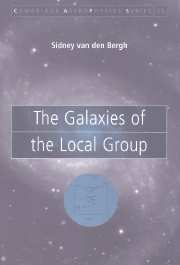Book contents
- Frontmatter
- Contents
- Preface
- 1 Introduction
- 2 Local Group membership
- 3 The Andromeda galaxy (M31)
- 4 The Milky Way system
- 5 The Triangulum galaxy (M33)
- 6 The Large Magellanic Cloud
- 7 The Small Magellanic Cloud
- 8 The elliptical galaxy M32 (= NGC 221)
- 9 The irregular dwarf galaxy NGC 6822
- 10 The starburst galaxy IC 10
- 11 Faint dwarf irregular galaxies
- 12 Spheroidal galaxies
- 13 The most luminous dwarf spheroidal galaxies
- 14 Dwarf spheroidals in the Andromeda subgroup
- 15 Faint dwarf spheroidals
- 16 The outer fringes of the Local Group
- 17 Intergalactic matter in the Local Group
- 18 Dynamical and physical evolution
- 19 Properties of the Local Group
- 20 Conclusions
- Glossary
- Bibliography
- Object Index
13 - The most luminous dwarf spheroidal galaxies
Published online by Cambridge University Press: 22 August 2009
- Frontmatter
- Contents
- Preface
- 1 Introduction
- 2 Local Group membership
- 3 The Andromeda galaxy (M31)
- 4 The Milky Way system
- 5 The Triangulum galaxy (M33)
- 6 The Large Magellanic Cloud
- 7 The Small Magellanic Cloud
- 8 The elliptical galaxy M32 (= NGC 221)
- 9 The irregular dwarf galaxy NGC 6822
- 10 The starburst galaxy IC 10
- 11 Faint dwarf irregular galaxies
- 12 Spheroidal galaxies
- 13 The most luminous dwarf spheroidal galaxies
- 14 Dwarf spheroidals in the Andromeda subgroup
- 15 Faint dwarf spheroidals
- 16 The outer fringes of the Local Group
- 17 Intergalactic matter in the Local Group
- 18 Dynamical and physical evolution
- 19 Properties of the Local Group
- 20 Conclusions
- Glossary
- Bibliography
- Object Index
Summary
Introduction
Inspection of Table 2.1, which lists the known members of the Local Group, shows that dwarf spheroidals are the most common type of galaxy in the Local Group. Observations of rich clusters (Trentham 1998a,b) appear to show that the faint ends of their luminosity functions are steep. Moreover, the colors of these faint galaxies suggest that they are mostly dwarf spheroidals. Since dwarf spheroidals are ubiquitous in poor clusters, and even more frequent in rich clusters, it appears safe to conclude that such dwarfs are the most common type of galaxy in the Universe. The fact that they were not discovered until 1938 is entirely due to their low luminosity. Their discoverer (Shapley 1943, p. 142) writes
Perhaps not a great deal can be or needs to be known about them. They are relatively simple. And already they have made their greatest contribution by revealing themselves as members of our family of galaxies, and by possessing such low luminosities that they increase to six (out of eleven) the number of dwarfs among us. This result is upsetting, because it implies that our former knowledge and assumptions concerning the average galaxy may need serious modification. Moreover, the estimates of the total number of external organizations, and the total mass of the Metagalaxy will be involved in the reconsideration. Two hazy patches [the Sculptor and Fornax dwarfs] on a photograph have put us in a fog.
The suggestion that dwarf spheroidals might be distributed uniformly throughout the Local Group (Ambartsumian 1962) appears to conflict with the observation that strong clusterings of such objects are now known around the Milky Way system and the Andromeda galaxy.
- Type
- Chapter
- Information
- The Galaxies of the Local Group , pp. 219 - 233Publisher: Cambridge University PressPrint publication year: 2000

